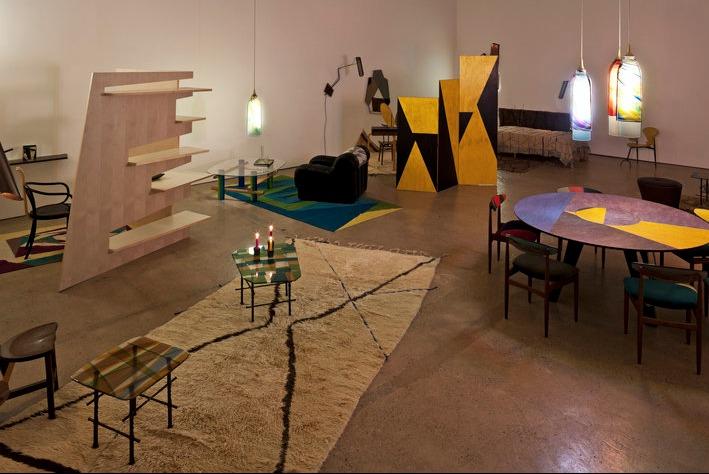First published in Vault, November 2013
Known for his famed 100 Chairs in 100 Days project, Italian-born designer Martino Gamper broaches the collision of forms, the collusion function and the cultural symbolism of materials in his unique recasting of domestic furniture.
Martino Gamper trades in joyful collisions. In 2007, the London-based furniture designer spent 100 days showing the world that happy accidents can give way to new beginnings. How a guitar can double as a shapely backrest when paired with a shelving unit, for instance. Or how an overturned wire basket, couched in curved wood, can enjoy a jaunty reincarnation as a seat.
“I was starting to become a bit disillusioned with the design world and the big names associated with it,” says Gamper, his softly accented English hinting at a childhood spent in the Italian Alps, where he started a cabinetmaking apprenticeship at the age of 14. “I’d been asked by some smaller companies to design chairs for them but found it really difficult to suddenly, from nothing, design a chair and make it amazing.”
He began “playing” with existing pieces of furniture, reclaimed pieces and materials as his creative salve. “I set myself this kind of project, where basically I had time and space to decide what a chair could be,” he recalls. “It was very much an act of three-dimensional sketching, where I didn’t put pressure on myself to deliver this amazing design.”
100 Chairs in a 100 Days, a project which saw Gamper salvage discarded material from street corners and friends’ apartments over a two-year period before creating new iterations in his East Hackney studio, is a kind of humble discourse on the underpinnings of the chair. It also foregrounds the ways in which design objects are the product of messy histories, the sum of both past and future lives.
“Some chairs are serious, some are funny, some are hilarious,” he says with a laugh. “For me it was very much about opening up new possibilities.”
But while Gamper – who studied sculpture under Michelangelo Pistoletto, one of the pioneers of the Arte Povera movement, at the Academy of Fine Arts in Vienna before relocating to study at London’s Royal College of Art in 1998 – lays claim to a surplus of wit, it’s dangerous to confuse this with a lack of rigour or an absence of ambition. For example, suede upholstery covering a plastic lawn chair might win points for user comfort, but it also highlights the malleability of class structures by drawing attention to the socio-economic taxonomies of particular materials. Elsewhere, a bicycle seat welded to a graceful wooden stand riffs on the work of late Milanese industrial designer Achille Castiglioni, all the while mapping the tension between aesthetic beauty and utilitarianism, a recurring theme in his work.
He also admits to struggling with design’s inability to speak to all experiences, even as it attempts to universalise them. “Function is the most challenging aspect of design,” he says. “What may be functional to me might not be the same for you. Comfort is even more difficult. But I try to respect that.”
Gamper’s chairs, which were first displayed in a Cromwell Road terrace house and have since been shown everywhere from the London Design Museum to San Francisco’s Yerba Buena Centre for the Arts, also trouble the notions of repetition and the tyranny of perfection that pervades much of design culture – a feat he attributes to the temporal aspects of the project. “There are certain limitations when you give yourself a day to make a chair. In the beginning, it actually freezes you but then you realise that a day is actually quite a long time. It means it’s easier to make decisions,” he offers.
“Sometimes, if you try to rework an idea, it doesn’t become any better with time. The initial thoughts are often the best ones.”
Instinct is often Gamper’s guiding force. His affinity with the visceral process of making – rather than the intellectualised act of designing – saw him remodel chairs by Carl Mollino, previously housed in Turin’s Lutrario Ballroom, as part of Design Miami/Basel 2008. The discovery of synergies between his own practice and that of Francis Upritchard, a New Zealand artist who fashions playful sculptures out of found objects, led to a group show at New York’s Salon 94 and an exhibition at Kate MacGarry Gallery in London, before the two eventually wed. And a fierce longing for the connection forged between customers and restaurant owners – honed cooking in Italian pizzerias and Swiss hotels in Europe and New Zealand and promptly lost when he moved to London – sparked Trattoria al Cappello, a pop-up dinner event staged with long-time collaborators Abake, a design collective spanning France, Wales and Sweden.
“Trattoria al Cappello came out of my interest in food, meeting people and collaborating,” he says. “It allowed me to blur the boundaries a bit. Obviously, as designers we design chairs, tables and interiors and the trattoria enabled us to do both. It was interesting mixing various fields together – a different way to communicate what I was doing.”
The pop-up dinners, which unfold once a month in various London locations and are furnished with tables, cutlery, and hand-blown water jugs conceived by Gamper and Abake, are testament to his interest in design’s ability to shape and influence the everyday.
It’s an idea that Gamper explored in Condominium, a 2011 solo exhibition in which a series of furniture installations housed in a 19th century Turin building weave narratives about fictional inhabitants, and one he will revisit at a new show, TU CASA MI CASA, at The Modern Institute in Glasgow this November.
“I’ve known Toby [Wilson] from The Modern Institute for years and we’ve always talked about working on a project together,” Gamper says. “I think Condominium caught his attention. The Modern Institute recently launched a new experimental gallery space and I’ve always been very interested in working with spaces in a very site-specific way.”
The Modern Institute show will see Gamper pit the transformative power of art against design’s basis in lived experience – a move that has become his calling card.
“I started off as a maker and went into design later on in my life. Because of this experience, I try to combine the two in every project – the making and the thinking/”
TU CASA MI CASA shows at The Modern Institute from November 9 to January 25, 2014.
martinogamper.com
themoderninstitute.com

